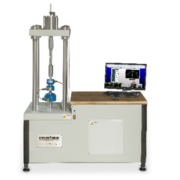Excitation Voltage 101
 Excitation is an electrical signal. The excitation voltage is represented by the volts direct current (VDC). The direct current flows in one direction only. Alternating current (AC) changes direction at times.
Excitation is an electrical signal. The excitation voltage is represented by the volts direct current (VDC). The direct current flows in one direction only. Alternating current (AC) changes direction at times.
Load cell excitation provides a voltage to generate an output signal, sometimes referred to as ‘powering’ the load cell. An output signal from a load cell is typically minimal, so an excitation voltage is needed to power the load cell and ensure the output signal is accurate. The magnitude of the output signal is proportional to the amount of force applied to the load cell. The greater the force, the greater the output signal.
Interface load cells contain proprietary strain gages applied to a Wheatstone bridge, essentially an electrical circuit that changes resistance when subjected to strain. The Wheatstone bridge is comprised of strain gages that are arranged in a specific configuration. When a load is applied to the load cell, the strain gages deform, and their resistance changes. This change in resistance causes the output voltage of the Wheatstone bridge to change.
Interface provides electrical performance data on all specifications represented as VDC MAX, when applicable. The data for excitation voltage is listed under the electrical section of a transducer model’s specification datasheet, along with other factors, including rated output, bridge resistance, and zero balance.
Sensor Power and Excitation Tips
Load cell excitation is necessary to ensure the accuracy and reliability of load cell measurements. Here are a few tips to consider regarding excitation and power signals when designing a force measurement system:
- The output signal from a load cell is expressed in millivolt output per Volt (mv/V) of excitation at capacity.
- The excitation voltage also affects the magnitude of the output signal. A higher excitation voltage will produce a higher output signal.
- The output signal is directly affected by the input voltage. It’s essential to maintain a stable excitation voltage.
- Interface load cells all contain a full bridge circuit. Each leg has a typical bridge resistance of 350 ohms, except for models like our 1500, which have 700 ohm legs.
- The preferred excitation voltage is 10 VDC, which guarantees the closest match to the original calibration performed at Interface before it is shipped from our factory.
- A DAQ system won’t always provide stable excitation voltage. Consider using a signal conditioner or DAQ with specific bridge inputs.
Why Load Cell Excitation Matters
Excitation matters in force measurement applications because it provides the power needed to operate the load cell and ensure an accurate output signal. The load cell cannot generate an output signal without excitation, and the force measurement will be inaccurate. In addition, it does influence accuracy, noise, and range.
Accuracy: The excitation voltage powers the load cell and ensures an accurate output signal.
Noise Reduction: The excitation voltage can help to reduce noise in the output signal.
Range: The excitation voltage can help extend the load cell’s measurement limit.
The excitation voltage should be applied to the load cell in a balanced manner. This means the excitation voltage should be applied to both sides of the load cell. The excitation voltage should be stable. This means that the voltage should not fluctuate or drift over time. The excitation voltage should be filtered. This means that any noise in the excitation voltage should be removed.
Excitation 101 in Force Measurement
The excitation voltage determines the sensitivity of the load cell. A higher excitation voltage will result in a more sensitive load cell, which means it can measure smaller forces.
The excitation voltage influences the frequency response of the load cell. A higher excitation voltage will result in a broader frequency response, meaning the load cell can track changes in force more accurately.
Linearity measures how accurately the load cell converts force into an electrical signal. A higher excitation voltage will result in a more linear load cell, meaning the output signal will be more proportional to the applied force.
The excitation voltage is well-regulated to reduce measurement errors. Variations in excitation voltage can cause a slight shift in zero balance and creep. This effect is most noticeable when the excitation voltage is first initiated. The solution is to allow the load cell to stabilize by operating it with a 10 VDC excitation for the time required for the gage temperatures to reach equilibrium. The effects of excitation voltage variation are typically not seen by users except when the voltage is first applied to the cell.
For tips like this, please consult Interface’s Load Cell Field Guide. We also detail remote sensing of excitation and temperature. Download your copy for free here.
It is essential to carefully select the excitation voltage for a load cell application to ensure that it can provide accurate and reliable measurements.








